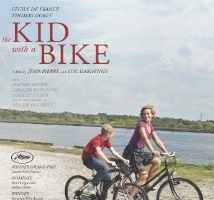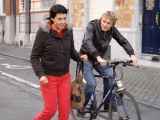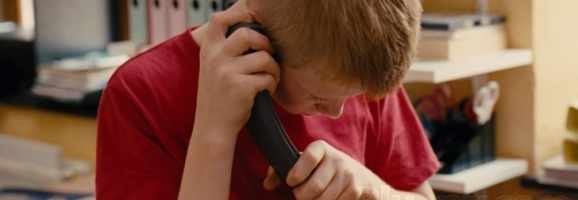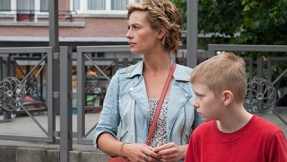The Kid with a Bike: A Youth Worker’s Perspective
I remember the first time I saw The Kid with a Bike, the Dardenne brothers striking look at child development. It was in Loring Hall, a decorative old building originally built for social gatherings in 1852 and later converted into a state-of-the-art picture house in 1936 in Hingham, Massachusetts, an affluent town just south of Boston. The film seemed to have an effect on all the patrons who attended the screening; as I walked to my car I was stopped by an elderly woman who was intent on discussing the film with someone, anyone. “Wasn’t the ending sad?” she posited with a furrowed brow. I half-heartedly nodded my agreement but if truth be told, I had read the film’s conclusion- in which Cyril (Thomas Doret) gets on his bike and rides home having nearly fallen to his death- quite differently.
At the time I had been working with disadvantaged young people from Boston for almost eight years, a job that involved me interacting with kids who were estranged from their parents for a variety of reasons, a lot of whom now found themselves, like Cyril, either living in a home for abandoned youth, or in foster care. While working closely with these troubled youngsters I had experienced the temper tantrums, the power struggles, the communication shutdowns and the violent outbursts that feature prominently throughout the Dardennes’ film. They didn’t just seem believable to me, they were real; because I had witnessed them firsthand.

The Dardennes have a reputation for accurate portrayals of gritty social and political situations and the strain they can have on the family unit. Their previous film, Lorna’s Silence, touched on issues of organised crime, flaws in immigration policies, abortion and drug abuse within its modest running time of 105 minutes. The importance of patriarchal and matriarchal figures is another recurring theme. Their 1999 film Rosetta follows the struggles encountered by a young woman with an alcoholic mother and her journey to avoid becoming like her. 1996’s The Promise focused on the story of a teenage boy taking his first steps to embracing adulthood by turning his back on his father’s wishes and forming his own moral code. These films highlight the difficulties surrounding adolescence, but the brothers are equally adept at telling a family drama from the perspective of the parents. The Son (2002) is about a man who attempts to overcome the death of his child by hiring an apprentice, the youth responsible for his son’s death. In The Child (2005) a petty criminal renounces his nefarious ways to be a dedicated father, albeit after attempting to sell his son.

Their stories are often motivated by the harsh realities of everyday life, no doubt influenced by their early career in which they made around 60 documentaries on a vast array of topics from anti-Nazi resistance groups to Polish immigration. Their feature films are a natural progression in their career, using fictional stories to make important social and political statements. They adopt an intensely naturalistic style which includes casting non-professional actors, long takes with a roving camera, as well as the resistance to use non-diegetic music. This approach to filmmaking creates almost a scripted documentary, turning their camera into a window to the plight of the struggling Belgian lower classes which is the focus of their films.
In The Kid with a Bike, the brothers do not drift far from the aesthetic template of their previous films (although they do sneak in some scored music towards the film’s conclusion). For the role of Cyril they cast Thomas Doret, an amateur who was appearing in his first film, as well as using numerous long shots with their typical restless camera. Like so much of their past work, the film is set in Saraing, a small town in the Province of Leige, known for its steel production. The camera work and location are just window dressing however; the reason behind the film’s authenticity is the accuracy of its observations on behaviour of troubled youth. The performances from the cast, in particular Doret and Cecile De France, are startlingly persuasive, blurring the lines of fact and fiction in a way I have never seen before in cinema.
These performances are not a fluke but the product of the Dardennes’ canny ability to guide their players to the portrayal they want, something honest and real. Their concern is with the physical, encouraging the actors to try different things in each take in order to get the best from them. It is the same technique that allowed Jeremie Renier to effectively show Igor’s transformation from a boy, his father’s son, into his own free-thinking adult in The Promise, and Arta Dobroshi to garner both sympathy and resentment for her treatment of her drug-addicted husband in Lorna’s Silence. The challenge is even greater in The Kid with a Bike due to the age of their leading man, Doret was just thirteen when he played the role, his first ever acting gig; a blank canvas for the brothers to work with.
It is a remarkably physical performance from Doret: mature, visceral and intense. It shows the comfort and confidence of a performer several times his age. From the opening moments he demands attention through the use of body language alone. The opening shot is of Cyril on the phone attempting to call his father from the state run shelter he is currently living in. He stands there like a half-shut knife, his head stooped looking at the ground, his fall back position when faced with uncertainty. His shoulders are slumped down, he knows deep down, even if he cannot admit it to himself, that his father won’t be answering the phone. An attempt from an unseen staff member to get him to hang up the only results in Cyril drawing further into himself, twisting his shoulders away from the worker, isolating himself even more. At this point the worker attempts to reach out to him to take the phone away, resulting in Cyril to leap back like a startled deer.

It is a common sight when working with at-risk youth who have lived a life of constant disappointment and hardship. Children with abandonment issues such as Cyril will often suffer from a distinct lack of confidence displayed in Doret’s choice of body language. Other issues that arise from abandonment include the inherent lack of trust of others, which is also clearly displayed in Cyril’s reaction to the staff member when he reaches out to him. Larry Epstein, Director of School-Based Services with Think:Kids, a program at Massachusetts General Hospital designed to work with troubled youth, suggests that this lack of emotional development is little more than a skill the child has not yet learnt due to their circumstances. Cyril should indeed be able to distinguish a harmful gesture from a benign one, but due to his lack of nurturing from a young age, he has not developed that set of skills, thus making his reaction to the movement of the staff member apt.
There is further evidence of the quality and accuracy of Doret’s physical performance in a sequence midway through the film in which Cyril finally tracks down his absent father Guy (played by Dardenne regular Jeremie Renier), who has abandoned his son to move in with his girlfriend and start a new job as a chef. Leading up to this scene, Cyril has been in total denial about his father’s desertion, convincing himself that his father is just getting things ready for him to come live with him. In this sequence, the truth is finally forced upon him. Guy does not want to look after Cyril any more and he wants him out of his life. The lack of emotional connection between father and son is evident from the moment they come face to face. After their greeting, they stand for a prolonged period exchanging idle pleasantries, neither knowing exactly what to say to the other. Having constructed this fantasy image of his father, Cyril is now thrust into the reality of who his father is and what he can expect from him. Having spent so much time and effort to find him, he is clearly nervous, he doesn’t take his eyes off his dad, his anxiety subtly displayed in his uncertainty in what to do with his hands, as well as the manner in which he follows Guy like a shadow as he moves around the kitchen, trying to avoid his sons questions.
The lack of familial bond between father and son in this sequence is awkward and difficult to watch, but pales in comparison to the scene that follows in which Cyril breaks down on the drive home following Guy saying he no longer wants to see him. Here Doret displays a plethora of emotions commonly associated with troubled and abandoned youth. Beginning with a side close up of his face, we see Cyril taking in what has just occurred, rapidly blinking to flight back the tears. As Samantha attempts to comfort him by gently placing her hand on his shoulder, he violently jerks away in a similar manner to which he shied away from the staff member at the care home in the opening scene. Burying his head against the car door, he then completely shuts down, not responding to Samantha, a common reaction for troubled youth when faced with emotional trauma. And then the most disturbing moments, as Cyril without warning begins to claw at his face and, when Samantha attempts to restrain him, bang his head off the car door. Like the emotional shutdown, the violent outburst is all too familiar with youth who lack the skills or experience to express their anger in a more appropriate manner. After the rage, finally Cyril is ready to breakdown in floods of tears, releasing the hurt his father has caused. It is the most harrowing moment in the film, in under a minute Doret has cycled through a wide spectrum of emotions associated with kids from troubled backgrounds. This sequence more than any other shows the unpredictable nature of working with such children and the troubles they endure to make sense of a world that has treated them so poorly.
It is not just the phenomenal physical performance of Doret that makes The Kid with a Bike such a faithful representation of the working with at-risk youth; the manner in which Cyril interacts with the adults he comes into contact with are also symptomatic of the struggles for both child and grown up. From someone who has worked in childcare for many years the relationships that had the most resonance for me were the interactions between Cyril and the staff of youth home he is living in at the beginning of the film. It is clear from the opening moments that the Dardennes are not interested in portraying these staff members in a positive light, they are interchangeable, faceless employees who seem to have become disillusioned with their work. Indeed they are often used as an example of how not to deal with a difficult child.
Returning to the opening scene in which Cyril attempts to telephone his father, there are clear indicators that the staff of the care home are not suited to be looking after Cyril. After the first phone call fails and Cyril is reluctant to relinquish the phone, suggesting the staff member dialled the number wrong, the worker initially handles this appropriately, calmly suggesting they call back with it on speaker phone, and if they get the same message then they must move on. Cyril agrees to this and, unsurprisingly, they get the same message. It is here that worker starts to make mistakes, it does not occur to him that this may be distressing to Cyril. When no-one answers the worker immediately regards the matter as closed, absentmindedly telling him to go play outside, without considering the emotional distress not being able to contact his father may have on Cyril. Instead of taking the time to guide Cyril through this upsetting occasion the worker instead quickly loses his temper with him when he suggests they call the superintendent of his father’s building. This is made worse when he attempts to wrestle the phone out of Cyril’s hand, feeling cornered and vulnerable, the child lashes out, biting the man, before running away from the home. The speed of the escalation, from telephone conversation to violence outburst is indicative of the delicate nature of working with fragile youth, it does not take a lot to push a minor altercation into a major issue.
Disputes like this are common, youth workers usually have long shifts and so their level of patience is not as high as it should be. A situation like this could easily be avoided if the worker had been more understanding of Cyril’s feelings and taken the time to explain the situation to him, sympathetically trying to make him understand things and work with him to try and resolve it. The general tone of the staff member in the scene suggests that this has been an ongoing issue with the child and that he has reached the end of his patience. A later sequence in which Cyril runs away again produces similar results. The staff members corner Cyril in a doctors office, approaching him in a manner he finds threatening, leading him to latch on to the nearest person to him, in this case it is Samantha, who was waiting in the office. An action that changes Cyril’s fortunes in the long run.
Looking now at the importance of Samantha for Cyril’s development; in her book about child development, Marion Dowling states that; “young minds are strengthened through warm and loving relationships, demonstrated through close attachments with key persons.” It is clear that Cyril has never had the opportunity to develop with the help of a loving family, lacking the intra- and inter-personal skills which are crucial to understanding the feelings of others, as well as his own, which makes him easily frustrated at the world and more prone to violent outbursts. Samantha plays the role of the “key person” Dowling is referring to, caring for Cyril in a manner which no-one ever has before. Showing more patience than the care workers when Cyril becomes unresponsive, she handles these issues with sympathy and patience. For a child who has been rejected their entire lives, the process of learning to trust an adult is a slow one, one that they will often put to the test to see if it is genuine- hence the regular power struggles between the two- but after a harrowing scene towards the film’s conclusion, which leads to Cyril stabbing her arm, she proves herself to him as someone he can finally rely on fully.
Despite the Dardennes’ reputation as ultra-realistic filmmakers, numerous critics viewed The Kid with a Bike as their version of a fairytale. While the city of Saraing, the setting of most of their feature works, is known for its heavy industrialisation, it is located in a region of Belgium that is steeped in folklore, with old-wives tales of witches living in wooded countryside. With this in mind, the character of Samantha has been read with a supernatural twist; a fairy godmother to Cyril. Appearing out of no-where, magically returning the boy’s prized bicycle to him, and then out-of-the-blue agreeing to save him from the oppression of the care home by letting him stay with her at weekends. While looking after Cyril she makes many sacrifices for him, suffers verbal and physical abuse, supports Cyril when he has legal issues, and even chooses Cyril when her boyfriend presents her with an ultimatum.
Admittedly, there are aspect of Samantha’s character that seem a little far fetched to the causal viewer, going above and beyond the call of duty for a child she barely knows. Her actions are not out of the ordinary for people that have spent many years working in youth development however. From a professional point-of-view, Samantha exhibits the patience, nurturing and empathy that is essential when working with disadvantaged youngsters. She offers Cyril the support he needs through good and bad times that he has been lacking throughout the crucial periods of his personal development. To some her actions may seem superhuman. For someone who has spent almost a decade working with children like Cyril, it is common to come across this type of person who is willing to work with a troubled youngster to help them become a well-rounded grown up.

Dowling suggests that children’s ability understanding their feelings are heavily dependent on the support they receive from their families. Looking back at the film’s conclusion, in which Cyril is ambushed by a teenager he had earlier assaulted in an attempted robbery, it is clear that Samantha’s hard work and sacrifices are already paying off for Cyril. He falls from a tree while attempting to escape, after which the teenager and his father panic. Assuming he is dead, they begin to make plans to absolve themselves from blame. It is a scene that reeks of social hypocrisy, when Cyril attacked them he was willing to face his punishment, this pair are not prepared to do the same and plan on using his background as their biggest defence. We never get to see if their nefarious plan would have succeeded. Cyril recovers while they are discussing it, and without so much as a look at his attacker, locates his bike and shopping, and rides home to his new secure family unit with Samantha. The elderly woman at the Loring Hall Cinema may have found the ending sad, but for someone who has seen the violent outbursts, temper tantrums, emotional breakdowns and moments of self harm, it is the happiest ending you could hope to see.
What do you think? Leave a comment.











Haven’t watched it yet, but will and I hope it’s going to be great since all of their earlier films from La promesse to Le silence de Lorna are amazing.
It was soooooo refreshing!! The directors style is incredibly real – beautifully so.
Really good article. It’s a really great movie and has some exceptional performances in it.
I read such great things about this movie and at the end when he rode off down the street, I just couldn’t believe it. Are you kidding me with this? After anything I watch I ask myself, was I entertained? This is a flat-out no. A few things, does this kid have any other clothes or anyone else for that matter? I can’t believe he wasn’t hit by a car with all of his running and biking around. Thank God I didn’t buy this movie.
I think this is a great film, and what made it great was that it was so naturalistic and believable.
The one part that jarred was when Cyril knocked out the man and son with the baseball bat. I’m sure that he wouldn’t really have been so skilled in knocking them unconscious. Just a couole of taps and they were both out cold!
I liked this movie very much.
It was heartbreaking to see the boy so eager to see the father who abandoned him, and like a puppy only too glad to be with his master who left him, still loyal when they met, and then had to accept the fact that his father doesn’t share the same feeling, doesn’t even want to see him again. Thankful that there is this compassionate Samantha who probably knew what the boy was going through and doing her best not to give up on the boy.
Few movies keep me interested from beginning to end; this one did! I found the movie exceptional.
What was the point of this whole movie?
Just grab a camcorder and film some neighborhood kids, it would be the same thing!
Completely unfinished and lame ending.
So some kid has family issues and some lady takes care of him. Wow! What a novel concept. Let’s make a movie about it.
Clearly you viewed the movie in the wrong state of mind. Did they actually have to show you footage of the barbecue to know it was a happy ending (the kid finally accepting his new situation and leaving the situation with the store owner for what it was)?
Looking forward to catching it. Nice and refreshing to see that there’s a sincere, non-mainstream movie out there.
I will have to check this movie out now. It is always great to see how story-telling can bring about social consciousness and, hopefully, change in how we address the issues of modern life.
This was an insightful piece and this seems like a movie I may want to check out.
Clearly an uncomfortable film about an uncomfortable subject. Haven’t seen it but have the feeling it would leave me drained. The analysis is deep and thoughtful and very detailed.
I thought that this piece was a great depiction of someone’s character with that type of upbringing. I have personal relationships with individuals with challenging backgrounds. Great analysis!!
Great movie. Cyril soon figures out where the love is. Its also interesting that the adults have the ability to forgive. Samantha forgives Cyril for stabbing her.The father forgives Cyril for hitting him with a bat but not the son. Cyril bites anyone who takes his bike. Children may hold resentments a lot longer than adults. Even eminem still has resentment towards his mother.Random comment but was just reading about that. The other theme I thought was the, close call to taking the wrong path. Cyril could have ended up in a gang and in jail.
Added to watch list.